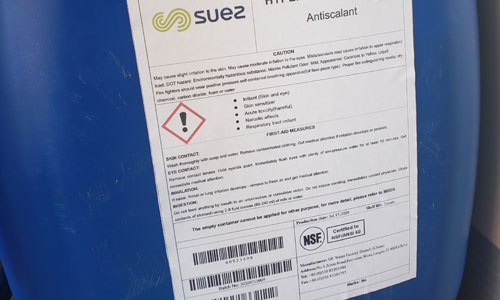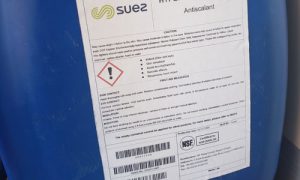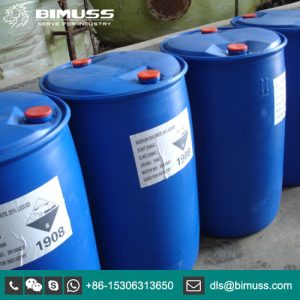Hypersperse MDC220

- Effectively controls scales including calcium carbonate up to LSI +3.0, calcium sulfate, barium sulfate, and strontium sulfate.
- Compatible with all of the leading RO membranes.
- Maintains cleaner membrane surfaces by dispersing particulate foulants.
- Effective over a wide pH range.
- May be fed neat or diluted.
Hypersperse MDC220- Antiscalant/Antifoulant
- Excellent results as a replacement for softener filters.
- Compatible with Solisep MPT150 coagulant.
- Classified for use in producing potable water. (Classified to ANSI/NSF Standard 60).
- Effectively controls scales including calcium carbonate up to LSI +3.0, calcium sulfate, barium sulfate, and strontium sulfate.
- Compatible with all of the leading RO membranes.
- Maintains cleaner membrane surfaces by dispersing particulate foulants.
- Effective over a wide pH range.
- May be fed neat or diluted.
- Good tolerance to aluminum and iron oxides.
DESCRIPTION AND USE
Hypersperse MDC220 is a highly effective liquid antiscalant/antifoulant developed to control scale pre-cipitates and reduce particulate fouling within mem-brane separation systems. Use of this product pro-vides longer run times and extended element life resulting in reduced operating and capital costs. Years of use in industrial applications show excellent results in membrane separation processes including reverse osmosis (RO), nanofiltration (NF) and ultrafil-tration (UF) applications.
PACKAGING INFORMATION
Hypersperse MDC220 is a liquid material, available in a wide variety of customized containers and delivery methods.
Contact your GE Betz sales representative for details.
APPLICATION
For maximum effectiveness, Hypersperse MDC220 should be added prior to the static mixer or cartridge filter housing.
For potable applications, the maximum dosage is 10 mg/L. Maximum dilution is 10% with RO permeate or DI water.
DOSING
Typical dosage range is between 2 and 6 mg/L
Important Note: Over and under-dosing may cause membrane fouling so please contact your local GE Betz representative to define the optimal feedpoint and dosage rate.
Maximum Dilutions
Maximum dilution is temperature related as shown below.
Temperature, °C |
| Maximum Dilution, % |
<30 | 10 | |
30-35 | 25 | |
>35 | 50 | |
SAFETY PRECAUTIONS
A Material Safety Data Sheet containing detailed information about this product is available upon request.


